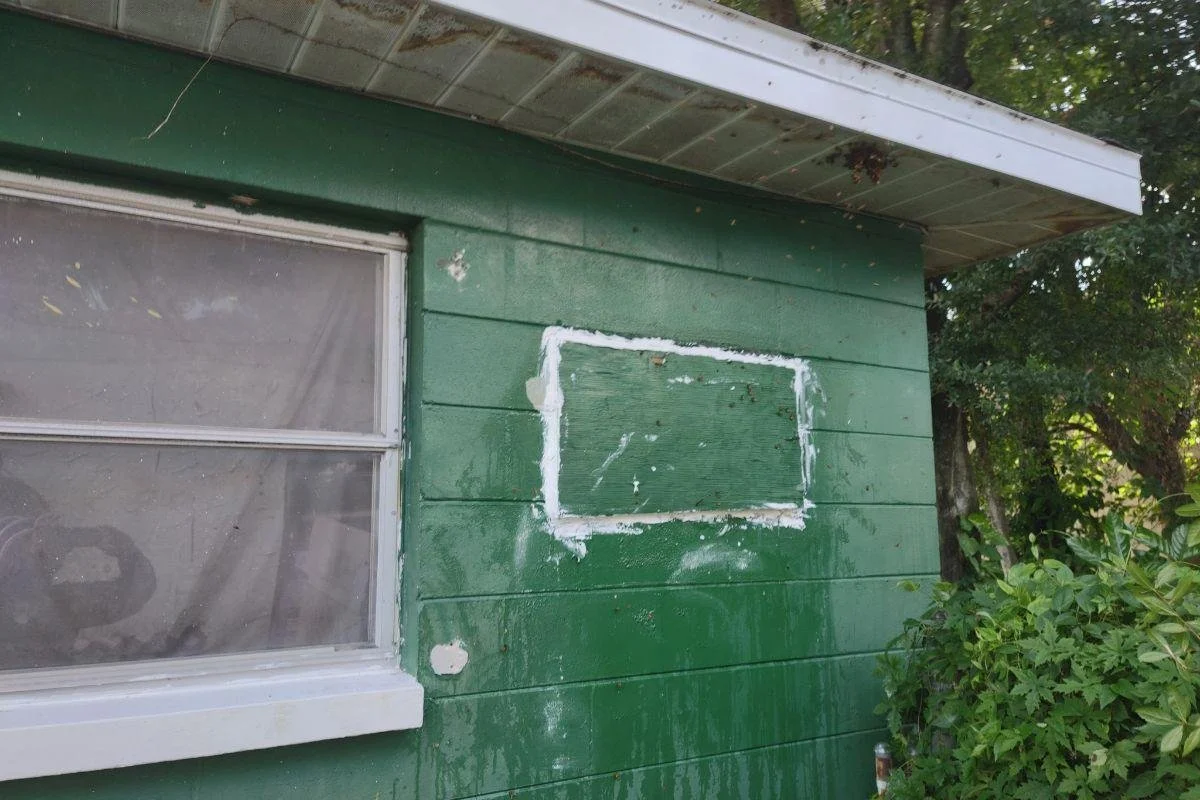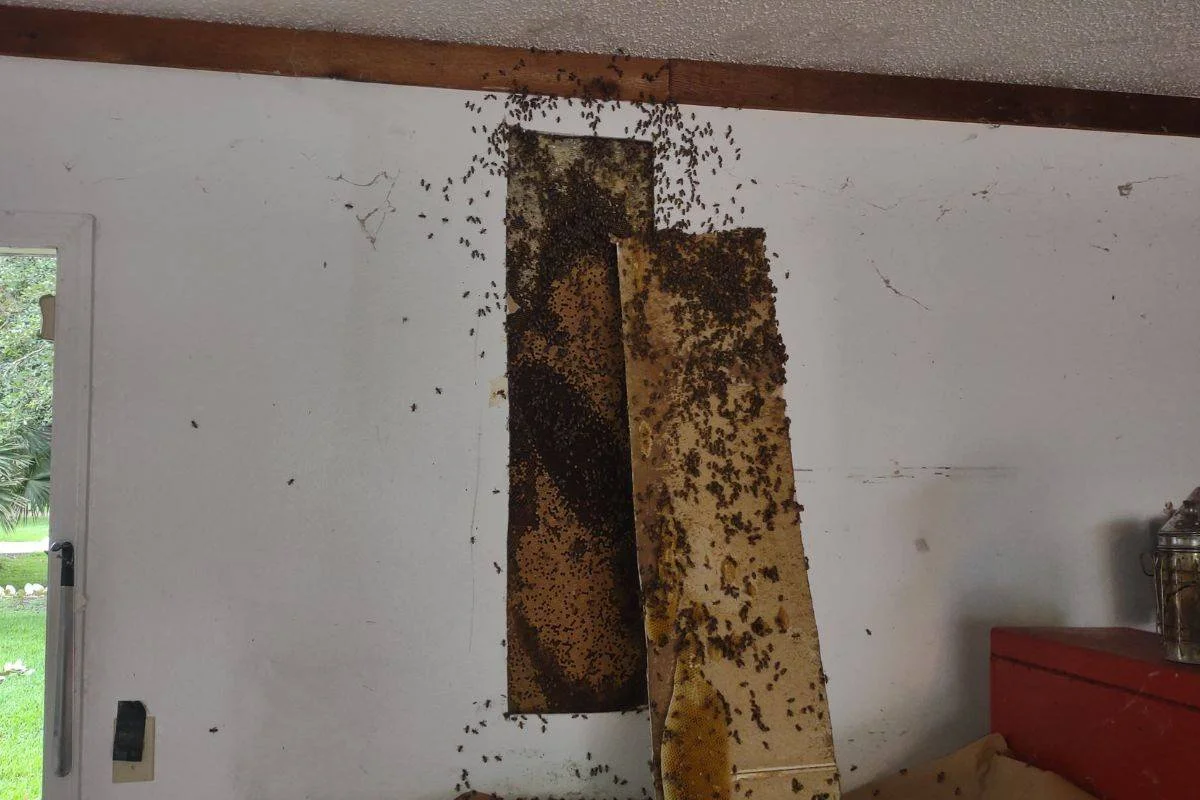How to Identify a Bee Infestation by Sound or Smell.
When it comes to a bee infestation, most homeowners expect to see bees flying around. But sometimes, the warning signs aren’t visual—they’re audible or even olfactory. Yes, you can often hear or smell a bee infestation before you see it. Recognizing these subtle cues early can help you take action before the colony becomes a serious structural or safety problem.
In this guide, we’ll show you exactly how to identify a bee infestation by sound or smell, what those signs mean, and when to call a professional bee removal expert.
Why Bees Choose Hidden Areas?
Before diving into the sensory signs, it helps to understand why bees often go undetected.
The wall was sealed after the bees were removed.
Honey bees and other bee species often build colonies in enclosed, quiet, and protected spaces. These locations may include:
Wall voids
Attics
Under floorboards
Inside the roof eaves
Behind chimneys
Inside porch ceilings
Between the walls of sheds or garages
Because these are not easy-to-see locations, you might not spot the bees immediately. Instead, sounds and smells become the first signs of trouble.
What Does a Bee Infestation Sound Like?
Bees aren’t silent. A healthy, active colony of honey bees can produce a variety of sounds depending on its size, activity, and location.
Here’s what to listen for:
1. Constant Buzzing or Humming: One of the most obvious signs is a low, continuous buzzing sound, especially in quiet areas of the home like attics, crawlspaces, or inside walls.
Where you’ll hear it: Walls, ceilings, floors, and attic corners
When: Most audible during the day when bees are active (mid-morning to late afternoon)
What it sounds like: A soft electric hum, similar to a faint vibration or refrigerator motor
If you hear a persistent humming sound in the same location every day, it may be bees. Wasps and hornets may produce sounds, too, but they’re usually more intermittent and sharper.
2. Clicking or Tapping Inside Walls: Sometimes, you may hear clicking or scratching sounds. This could be bees moving around inside walls or bumping into internal surfaces.
This is most common when the colony is expanding or bees are adjusting their space inside a cavity.
3. Increased Sound Over Time: If the volume of the buzzing increases over days or weeks, it may indicate the colony is growing. Larger colonies are louder and often more aggressive when disturbed.
What Does a Bee Infestation Smell Like?
A bee infestation doesn’t just make noise—it can also produce a very distinct smell.
1. Sweet or Musty Odor: Active honey bee hives have a warm, sweet scent that can turn sour or musty in closed spaces.
What it smells like: Warm honey, beeswax, or fermenting sugar
Where: The smell may be strongest near the hive opening (wall cracks, attic vents, porch beams)
When: Stronger on warm days when honey softens and wax melts
If the smell resembles an old, sweet syrup or rotting fruit in one area of the house (especially the wall or ceiling), it could mean there’s honeycomb behind it.
2. Decay or Rotting Odor: In some cases, if the colony has died or is under stress, the smell can shift from sweet to rancid.
Decaying honeycomb can spoil, and dead bees can build up inside enclosed structures.
Mold and bacteria may also develop, creating a foul odor that smells like wet socks or mildew.
This kind of smell may be strongest after rain or during periods of high humidity.
Why These Signs Shouldn’t Be Ignored
Early identification is key. Bee colonies grow rapidly in warm climates, and the longer they stay hidden, the more complex and expensive the removal becomes.
Risks of Ignoring a Hidden Bee Infestation:
Structural Damage: Melting honey can seep into insulation, walls, and wood, attracting pests and causing rot.
Attracts Rodents and Ants: Honey and wax draw unwanted pests.
Health Hazards: Mold from decaying honeycomb can lead to allergic reactions or respiratory problems.
Increased Aggression: A growing colony may become territorial and more likely to sting.
When and Where to Inspect
Live bee colony removal from inside a home's wall.
If you suspect a bee infestation due to sounds or smells, check these common hiding spots:
Wall voids behind exterior siding
Ceiling corners and recessed lights
Chimney interiors
Roof eaves and soffits
Porch overhangs
Gaps between floors or under crawlspaces
Important: Don’t try to open the walls yourself. Bees may become defensive if their hive is disturbed suddenly.
What You Should NOT Do
Don’t spray chemicals: Using pesticides or insect spray on a bee colony is dangerous and can worsen the problem. Dead bees, wax, and honey left behind can decay and smell worse.
Don’t seal the hole without removal: If you block the bees’ entrance without removing the hive, they’ll try to escape inside the house—or die and rot inside the wall.
Don’t ignore the smell: Even if you don't see bees, a strange smell should always be investigated, especially if it's sweet and persistent in the same spot.
When to Call a Bee Removal Professional
If you've identified any of the following, it’s time to call in a licensed bee removal specialist:
Continuous buzzing from inside your walls or roof
Sweet, waxy, or musty smells coming from structural areas
An increase in bee activity around your home, especially near eaves or vents
Visible bees entering a hole in siding, soffit, or roof gaps
Professional bee removers can locate the hive using sound detection tools and thermal imaging. More importantly, they can remove the hive safely without harming the bees—and without damaging your home.
Why Choose Eco-Friendly Bee Removal?
Choosing live bee relocation over extermination is better for the environment and your home.
Preserves Pollinators: Honey bees play a crucial role in food production and plant biodiversity.
Prevents Long-Term Damage: Removal and cleanup ensure there’s no leftover honey, wax, or decay.
Safe and Humane: No harmful chemicals used. The bees are relocated to local apiaries or bee sanctuaries.
If you're in Florida or any other warm climate, bee infestations are especially common, and our team at Eco Bee Removal is ready to help.
Final Thoughts
Recognizing a bee infestation by sound or smell isn’t always easy, but it’s one of the most important steps you can take to protect your home and the bees themselves.
Listen for persistent humming or buzzing
Notice any sweet or strange odors coming from the walls or ceilings
Watch for signs of bee activity near gaps or vents
If you suspect bees are living in your home—even if you don’t see them—don’t ignore the clues. Call a professional bee removal expert who can identify the infestation and relocate the colony safely.


